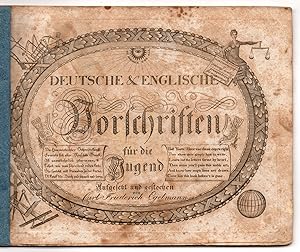Beschreibung
Oblong 16mo (6.25" x 8.2"), original blue wrappers with red paper spine. Engraved title leaf, 15 engraved plates. CONDITION: Good+, moderate wear to wrappers; foxing to contents. The 1831 edition of this elaborate and charming German-English penmanship book by important German-American engraver and almanac astronomist Carl Friederich Egelmann. Enclosed within an ornamental frame with a figure of Justice, a globe, and tools of mathematics and agriculture at each corner, short original poems on either side of the title invite the reader in both German and English to "Come buy this book" / "O! Kauf dis Buch." The following fifteen plates cover several German scripts-Kurrent, Fraktur, and "Canzelen Schrift" (a variation of the bureaucratic Kanzleischrift); the "English or Latin Alphabet"; "Chymical Signs" (in both English and German), and even cross-stitch letters and symbols "for marking on linen." In addition to alphabets and word lists are original poems signed in the plate by Egelmann and a variety of sampler texts, three of which are delightfully illustrated: "Vom Löwen" ("On Lions"); "Vom Elephanten" ("On Elephants"); and "Ermahnung an die Jugend" ("Reminder" or "Admonition to Children"). Unlike the version in earlier editions, the latter plate includes a small detail engraving to the left of the text illustrating how to use the "thumb and first two fingers of the right hand to hold the quill, and of the left hand to hold the paper." One of the plates here contains sampler text filled in with two dates in 1831. Nash identifies three editions of this work, in 1821, 1823, and 1831; a Library Company of Philadelphia exhibition catalog from 1983 notes "at least four editions between 1820 and 1831." Carl Friederich Egelmann (1782-1860) was born in Germany to a titled family. After serving as secretary to a baron in his late teens, he emigrated to the United States in 1802. He spent several years apprenticed to a coach maker (during which time he made the body of a coach for the brother of Napoleon), and learned copperplate engraving in his spare time. With his wife Anna Maria Schert (m. 1808) Egelmann eventually moved to Pennsylvania, first to Chester, where he taught school in both English and German, and then to Reading, where he launched his career as an engraver, becoming "the world's most productive almanac calculator. His calculations, articles, notes, illustrations and poems made a significant social and cultural impact on the life of the Pennsylvania Germans and people of surrounding areas during the 19th Century" (Winkler, p. 12). REFERENCES: Nash, American Penmanship 1800-1850 136; Germantown and the Germans (Philadelphia, 1983) 14; Winkler, Louis. "Pennsylvania German Astronomy and Astrology VII: Carl Friederich Egelmann," Pennsylvania Folklife Vol. 23, No. 1 (1973). Bestandsnummer des Verkäufers 8636
Verkäufer kontaktieren
Diesen Artikel melden
![]()




